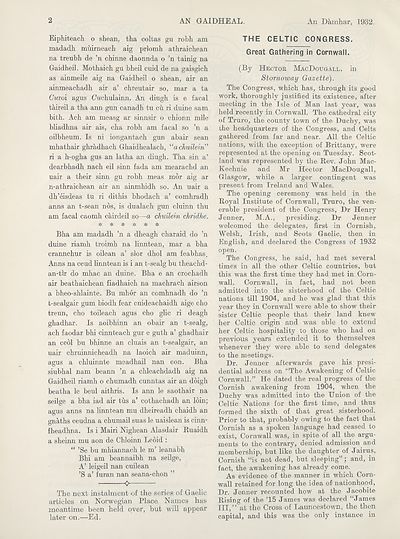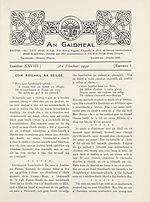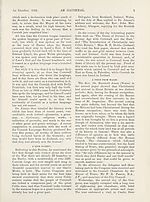Thumbnail gallery: Grid view | List view

AN GAIDHEAL.
An Damhar, 1932.
Eiphiteach o shean, tha coltas gu robh am
madadh muirneach aig priomh atbraichean
na treubh de ’n chinne daonnda o ’n tainig na
Gaidheil. Mothaicb gu bheil cuid de na gaisgich
as ainmeile aig na Gaidheil o shean, air an
ainmeachadh air a’ chreutair so, mar a ta
Cwroi agus Cwchulainn. An diugh is e facal
taireil a tha ann gun canadh tu cu ri duine sam
bith. Ach am measg ar sinnsir o chionn mile
bliadhna air ais, cha robh am facal so ’n a
oilbheum. Is ni iongantach gun abair scan
mhathair ghradhach Ghaidhealach, “achuilein”
ri a h-ogha gus an latha an diugh. Tha sin a’
dearbhadh nach eil sinn fada am mearachd an
uair a their sinn gu robh meas mor aig ar
n-athraichean air an ainmhidh so. An uair a
dh’eisdeas tu ri dithis bhodach a’ comhradh
anns an t-sean nos, is dualach gun cluinn thu
am facal caomh cairdeil so—a chuilein chridhe.
******
Bha am madadh ’n a dheagh charaid do ’n
duine riamh troimh na linntean, mar a bha
crannchur is oilean a’ sior dhol am feabhas.
Anns na ceud linntean is i an t-sealg bu theachd-
an-tir do mhac an duine. Bha e an crochadh
air beathaichean fiadhaich na machrach airson
a bheo-shlainte. Bu mhor an comhnadh do ’n
t-sealgair gum biodh fear cuideachaidh aige cho
treun, cho toileach agus cho glic ri deagh
ghadhar. Is aoibhinn an obair an t-sealg,
ach faodar bhi cinnteach gur e guth a’ ghadhair
an ceol bu bhinne an cluais an t-sealgair, an
uair chruinnicheadh na laoich air maduinn,
agus a chluinnte meadhail nan con. Bha
siubhal nam beann ’n a chleachdadh aig na
Gaidheil riamh o chumadh cunntas air an doigh
beatha le beul aithris. Is ann le saothair na
seilge a bha iad air ths a’ cothachadh an loin;
agus anns na linntean mu dheireadh chaidb an
gnaths ceudna a chumail suas le uaislean is cinn-
fheadhna. Is i Mairi Nighean Alasdair Ruaidh
a sheinn mu aon de Chloinn Leoid :
“ ’Se bu mhiannach le m’ leanabh
Bhi am beannaibh na seilge,
A’ leigeil nan cuilean
’S a’ furan nan seana-chon ”
0
The next instalment of the series of Gaelic
articles on Norwegian Place Names has
meantime been held over, but will appear
later on.—Ed.
THE CELTIC CONGRESS.
Great Gathering in Cornwall.
(By Hector MacDougall. in
Stornoway Gazette).
The Congress, which has, through its good
work, thoroughly justified its existence, after
meeting in the Isle of Man last year, was
held recently in Cornwall. The cathedral city
of Truro, the county town of the Duchy, was
the headquarters of the Congress, and Celts
gathered from far and near. All the Celtic
nations, with the exception of Brittany, were
represented at the opening on Tuesday. Scot¬
land was represented by the Rev. John Mac-
Kechnie and Mr Hector MacDougall,
Glasgow, while a larger contingent was
present from Ireland and Wales.
The opening ceremony was held in the
Royal Institute of Cornwall, Truro, the ven¬
erable president of the Congress, Dr Henry
Jenner, M.A., presiding. Dr Jenner
welcomed the delegates, first in Cornish,
Welsh, Irish, and Scots Gaelic, then in
English, and declared the Congress of 1932
open.
The Congress, he said, had met several
times in all the other Celtic countries, but
this was the first time they had met in Corn¬
wall. Cornwall, in fact, had not been
admitted into the sisterhood of the Celtic
nations till 1904, and he was glad that this
year they in Cornwall were able to show their
sister Celtic people that their land knew
her Celtic origin and was able to extend
her Celtic hospitality to those who had on
previous years extended it to themselves
whenever they were able to send delegates
to the meetings.
Dr. Jenner afterwards gave his presi¬
dential address on “The Awakening of Celtic
Cornwall.” He dated the real progress of the
Cornish awakening from 1904, when the
Duchy was admitted into the Union of the
Celtic Nations for the first time, and thus
formed the sixth of that great sisterhood.
Prior to that, probably owing to the fact that
Cornish as a spoken language had ceased to
exist, Cornwall was, in spite of all the argu¬
ments to the contrary, denied admission and
membership, but like the daughter of Jairus,
Cornish “is not dead, but sleeping”; and, in
fact, the awakening has already come.
As evidence of the manner in which Corn¬
wall retained for long the idea of nationhood,
Dr. Jenner recounted how at the Jacobite
Rising of the ’15 James was declared “James
III,” at the Cross of Launcestown, the then
capital, and this was the only instance in
An Damhar, 1932.
Eiphiteach o shean, tha coltas gu robh am
madadh muirneach aig priomh atbraichean
na treubh de ’n chinne daonnda o ’n tainig na
Gaidheil. Mothaicb gu bheil cuid de na gaisgich
as ainmeile aig na Gaidheil o shean, air an
ainmeachadh air a’ chreutair so, mar a ta
Cwroi agus Cwchulainn. An diugh is e facal
taireil a tha ann gun canadh tu cu ri duine sam
bith. Ach am measg ar sinnsir o chionn mile
bliadhna air ais, cha robh am facal so ’n a
oilbheum. Is ni iongantach gun abair scan
mhathair ghradhach Ghaidhealach, “achuilein”
ri a h-ogha gus an latha an diugh. Tha sin a’
dearbhadh nach eil sinn fada am mearachd an
uair a their sinn gu robh meas mor aig ar
n-athraichean air an ainmhidh so. An uair a
dh’eisdeas tu ri dithis bhodach a’ comhradh
anns an t-sean nos, is dualach gun cluinn thu
am facal caomh cairdeil so—a chuilein chridhe.
******
Bha am madadh ’n a dheagh charaid do ’n
duine riamh troimh na linntean, mar a bha
crannchur is oilean a’ sior dhol am feabhas.
Anns na ceud linntean is i an t-sealg bu theachd-
an-tir do mhac an duine. Bha e an crochadh
air beathaichean fiadhaich na machrach airson
a bheo-shlainte. Bu mhor an comhnadh do ’n
t-sealgair gum biodh fear cuideachaidh aige cho
treun, cho toileach agus cho glic ri deagh
ghadhar. Is aoibhinn an obair an t-sealg,
ach faodar bhi cinnteach gur e guth a’ ghadhair
an ceol bu bhinne an cluais an t-sealgair, an
uair chruinnicheadh na laoich air maduinn,
agus a chluinnte meadhail nan con. Bha
siubhal nam beann ’n a chleachdadh aig na
Gaidheil riamh o chumadh cunntas air an doigh
beatha le beul aithris. Is ann le saothair na
seilge a bha iad air ths a’ cothachadh an loin;
agus anns na linntean mu dheireadh chaidb an
gnaths ceudna a chumail suas le uaislean is cinn-
fheadhna. Is i Mairi Nighean Alasdair Ruaidh
a sheinn mu aon de Chloinn Leoid :
“ ’Se bu mhiannach le m’ leanabh
Bhi am beannaibh na seilge,
A’ leigeil nan cuilean
’S a’ furan nan seana-chon ”
0
The next instalment of the series of Gaelic
articles on Norwegian Place Names has
meantime been held over, but will appear
later on.—Ed.
THE CELTIC CONGRESS.
Great Gathering in Cornwall.
(By Hector MacDougall. in
Stornoway Gazette).
The Congress, which has, through its good
work, thoroughly justified its existence, after
meeting in the Isle of Man last year, was
held recently in Cornwall. The cathedral city
of Truro, the county town of the Duchy, was
the headquarters of the Congress, and Celts
gathered from far and near. All the Celtic
nations, with the exception of Brittany, were
represented at the opening on Tuesday. Scot¬
land was represented by the Rev. John Mac-
Kechnie and Mr Hector MacDougall,
Glasgow, while a larger contingent was
present from Ireland and Wales.
The opening ceremony was held in the
Royal Institute of Cornwall, Truro, the ven¬
erable president of the Congress, Dr Henry
Jenner, M.A., presiding. Dr Jenner
welcomed the delegates, first in Cornish,
Welsh, Irish, and Scots Gaelic, then in
English, and declared the Congress of 1932
open.
The Congress, he said, had met several
times in all the other Celtic countries, but
this was the first time they had met in Corn¬
wall. Cornwall, in fact, had not been
admitted into the sisterhood of the Celtic
nations till 1904, and he was glad that this
year they in Cornwall were able to show their
sister Celtic people that their land knew
her Celtic origin and was able to extend
her Celtic hospitality to those who had on
previous years extended it to themselves
whenever they were able to send delegates
to the meetings.
Dr. Jenner afterwards gave his presi¬
dential address on “The Awakening of Celtic
Cornwall.” He dated the real progress of the
Cornish awakening from 1904, when the
Duchy was admitted into the Union of the
Celtic Nations for the first time, and thus
formed the sixth of that great sisterhood.
Prior to that, probably owing to the fact that
Cornish as a spoken language had ceased to
exist, Cornwall was, in spite of all the argu¬
ments to the contrary, denied admission and
membership, but like the daughter of Jairus,
Cornish “is not dead, but sleeping”; and, in
fact, the awakening has already come.
As evidence of the manner in which Corn¬
wall retained for long the idea of nationhood,
Dr. Jenner recounted how at the Jacobite
Rising of the ’15 James was declared “James
III,” at the Cross of Launcestown, the then
capital, and this was the only instance in
Set display mode to:
![]() Universal Viewer |
Universal Viewer | ![]() Mirador |
Large image | Transcription
Mirador |
Large image | Transcription
| An Comunn Gàidhealach > An Comunn Gàidhealach Publications > Gaidheal > Volume 28, October 1932--September 1933 > (10) Page 2 |
|---|
| Permanent URL | https://digital.nls.uk/127131132 |
|---|
| Description | This contains items published by An Comunn, which are not specifically Mòd-related. It includes journals, annual reports and corporate documents, policy statements, educational resources and published plays and literature. It is arranged alphabetically by title. |
|---|
| Description | A collection of over 400 items published by An Comunn Gàidhealach, the organisation which promotes Gaelic language and culture and organises the Royal National Mòd. Dating from 1891 up to the present day, the collection includes journals and newspapers, annual reports, educational materials, national Mòd programmes, published Mòd literature and music. |
|---|---|
| Additional NLS resources: |
|

